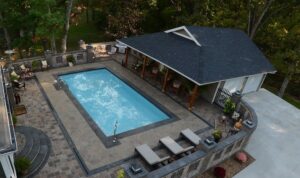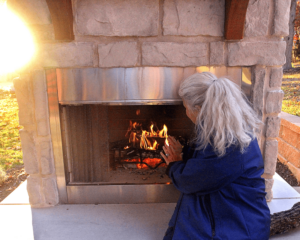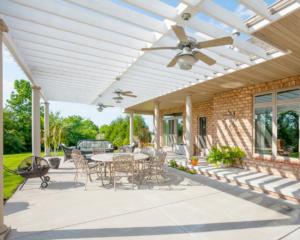Ready for a Beautiful Lawn?
Our Lawncare Fertilizer Program sets you up for success with timely fertilizer application by our licensed staff.
Fungicide Application Timeline
- Early Summer Application (May-June)
- Mid-Summer (June-July)
- Late Summer (July-August)
What are common lawn diseases (fungus) in Missouri?
Dollar Spot, Brown Patch, Summer Patch, Leaf Spot, Mildew and Blight.
What are symptoms of common lawn diseases?
1. Dollar Spot: Silver dollar-sized spots that contain white or tan colored leaves, it mimics a dog walking through paint. The lesions (spots) will be an hourglass shape with reddish bans marking the top and bottom of the glass shape.
2. Brown Patch: These are rings of brown colored grass that are usually sunken, surrounded by a smokey colored ring.
Summer Patch: Small round patches that are much slower growing and wilted. Will spread to irregular shapes with bronze coloration.
3. Leaf Spot: Black ‘burn-like’ spots appear, progressing to hourglass-shaped lesions on mid-level of grass blades; the lesion will exhibit dark brown to black bands on top and bottom of the hourglass shape.
4. Mildew: Grass will have a ‘white dusty’ appearance, almost as if flour were sprinkled on the grass. Sometimes the grass will look gray or ashy.
5. Blight: Irregular shapes that will appear ‘straw-like’, typically happening overnight.
What causes lawn fungus?
A common attribute with most fungi is the presence of moisture and heat. Lawns that are irrigated tend to exhibit these problems quicker and more frequently. If any of the symptoms above occur, quick action is the best plan. Most customers will increase watering when the grass begins to show signs of stress, but if fungus is present increased watering will worsen the situation. If more water is applied to the lawn and the problem areas do not improve (or they worsen), then this would be a strong indication of a fungus problem.
Proper identification of the problem is vital – then, once the fungus is identified, treatment needs to begin as soon as possible.
How can you prevent lawn fungus?
Most fungus can be prevented by a fungicide program. However, if there is already damage, a contact-based fungicide can be utilized to kill the fungus on contact and help slow or prevent the spread. Again, fungicides work best as a preventative.
Fungicides are probably one of the most expensive types of products used by homeowners and lawn care companies. But these products are highly encouraged to protect your investment. If the grass declines due to fungus and a fungicide is not used, then seeding in the fall is the next step to re-establish the lawn. Fungus can completely kill the grass, creating holes or large patches in the lawn. If caught early, a fungicide can halt the spread, which will allow the existing grass to continue normal growth. The mode of action or mechanism that allows these products to kill and/or prevent fungus will last for about 2-3 weeks. A repeat fungicide application is suggested to continue protection.
Air flow is another important aspect in fighting against fungus development.
How can you control lawn fungus?
1. Lawns that have a privacy fence will inhibit air flow – thus increasing fungus damage.
2. Landscapes that are heavily planted or have bigger varieties of plants will also block wind or air flow. Pruning lower branches as much as possible on trees and shrubs will aid in air flow. Thinning out plant material – such as spreading out landscape plants or completely removing some – will allow for increased air flow.
3. Utilizing more fungus resistant varieties of grass.
4. Proper watering habits.
5. Maintaining sharp mower blades.
6. Proper fertilizing.
7. Fungicide program (preventative).
Uncontrollable Factors:
- Low lying areas where fungus and moisture can settle overnight.
- Areas close to buildings, driveways, sidewalks, etc. will increase the soil temperature, allowing for a warmer environment that carries throughout the night.
- Nature, night-time dew, excessive rain fall, humidity, high temperatures.
How can you prevent lawn fungus?
Good mowing practices. Keep blades sharp during the growing season. Only cut off 1/3 of the grass blade at a time. Keep a proper mow height (3-4”) to allow the grass to dry properly and prevent stress on the grass. Proper mow height will also help conserve water for the grass.
Good watering techniques. Grass performs best with long, intermittent watering. Watering every day is ill-advised. During stressful summer months, increase the watering time rather than increasing the frequency (i.e., 3-4 days per week vs. everyday). Adjust watering time around rainfall as this can exacerbate the problem when coupled with the automated irrigation schedule.
Good fertilizing schedule. A lawn can suffer from both under and over fertilizing. If the grass does not receive the proper nutrients at the proper time of year, it will under-perform and lack the strength to develop and grow during times of stress. If too much fertilizer is applied, the grass will grow too quickly, allowing for weaker, spindly growth. A well-planned lawn care program will deliver the proper nutrient load at the right time, insuring a successful lawn.
Soil pH. This is an area that is often under-utilized or overlooked. It is highly encouraged to conduct a soil test every 2 years to know the soil pH, which will coincide directly with the type of fertilizer (macronutrients) and micronutrients needed. A typical lawn will benefit from a pH of around 6.0-7.0; a recommendation of lime or acid will bring the soil back in the safe range so that the grass can properly utilize the nutrients made available to the root system.
Dethatching and aeration. Dethatching is the mechanical process of removing and breaking up non-decomposed organic matter such as grass cuttings, stems, leaves and roots which collect on top of the soil. Aeration is the process in which plugs are punched/pulled at a depth of 3” or more in the soil. This loosens compacted soil, opens it up for more gas exchange (air to the root zone), and allows for better drainage and infiltration of water. The two processes also increase microbial action, which in turn helps decompose the organic matter buildup.
Fungicide program. Once again fungicides applied ahead of outbreaks or problems are most effective. Fungicides are sprays or granular products that contain biological organisms and inorganic material (i.e., copper, sulfur) to kill the fungus and/or spores. Essentially, a fungicide is a type of pharmaceutical product.
Grass type. A great recommendation is seeding your lawn with the proper grass type. A recommended grass type will be one that is naturally more resistant to fungus, or that is water conservative (has a low water demand). Choosing the right grass mix can save a lot of money, time, resources, and water.
Ready for a Beautiful Lawn?
Our Lawncare Fertilizer Program sets you up for success with timely fertilizer application by our licensed staff.



















